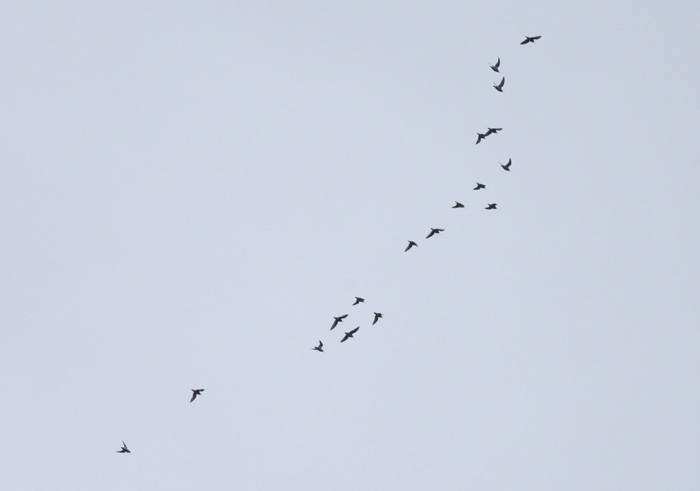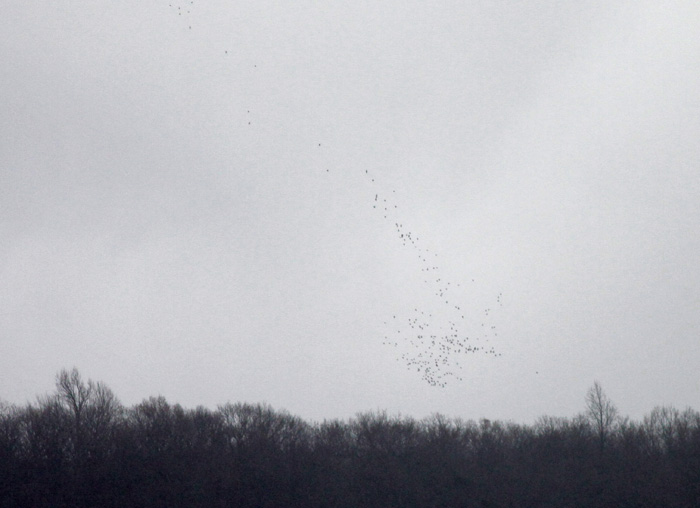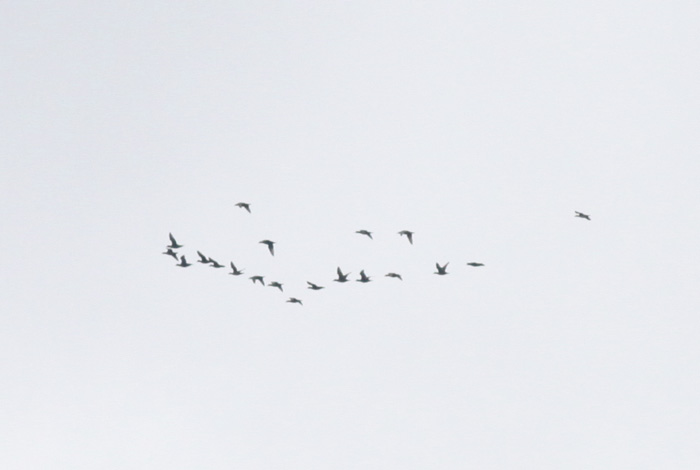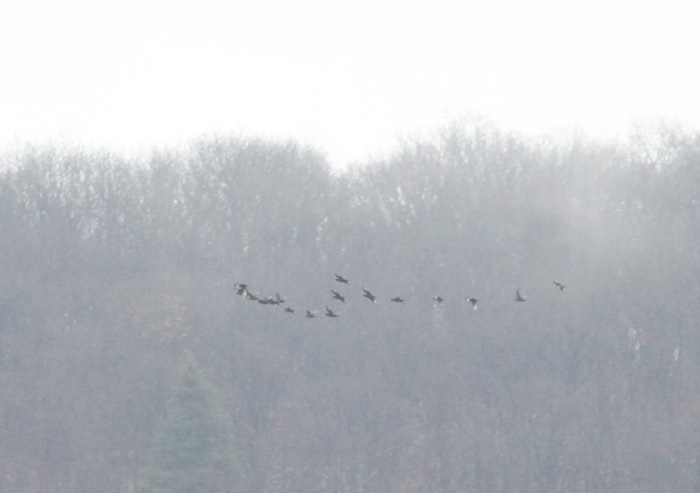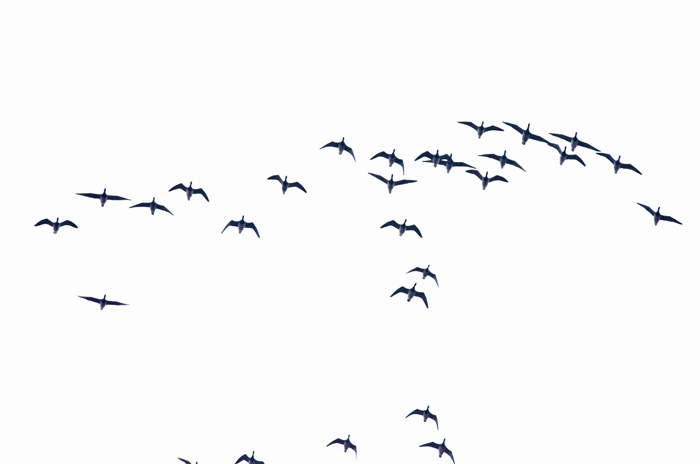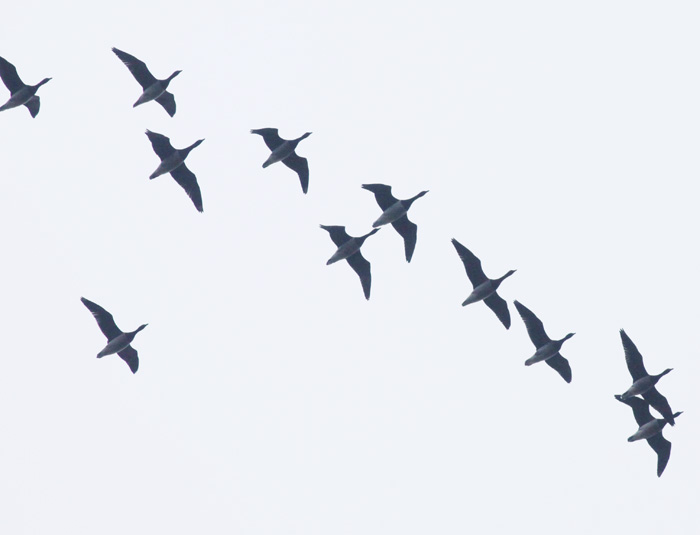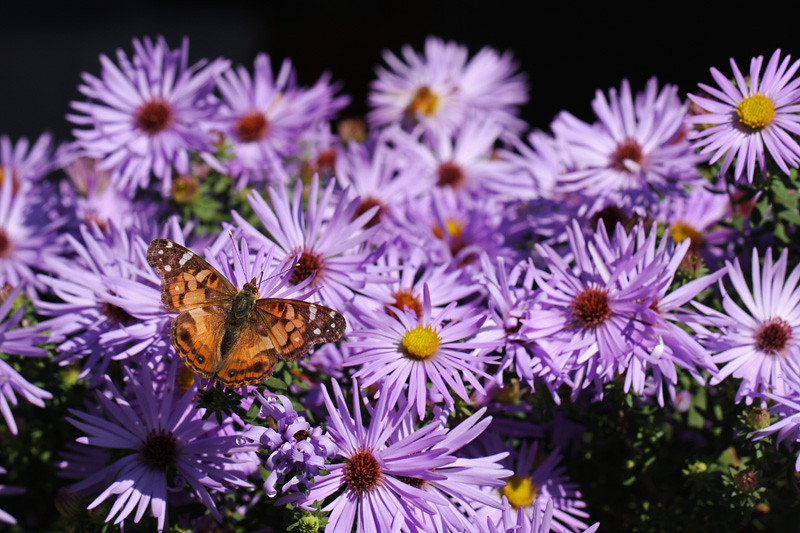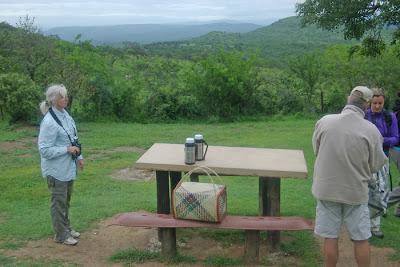You may remember that I visited South Africa back in November and December of last year. While I posted about the first few days I was there and the experiences I had at the United Nations conference, I hardly posted about the wildlife that I saw at the various locations I visited. Now, eight months later, here are some of the memorable wildlife sightings from the trip:
When we arrived at the airport in Cape Town, we met our host and headed to his house in Kensington, a neighborhood just outside of the main portion of Cape Town. After a little rest, we headed to the nearby neighborhood of Pinelands where there is a park running along a waterway. I had been able to do some birding from the car and airport, but this was my first time to walk around and get good looks at the birds in the area.
 |
| The park in Pinelands |
Some of the first birds we saw were Pied Crows. These noisy corvids were all over the place, sitting along the water, resting on houses, and chasing each other through the streets.
Not long after seeing the crows, I spotted a smaller black-and-white bird foraging along the water's edge. It bobbed its long tail up and down as it walked... wagtail! This Cape Wagtail then flew on top of a nearby house, where it sat for a second before continuing on its way. Wagtails are primarily a group of "old-world" birds, meaning they do not commonly occur in most of North America. As a result, this individual was the first representative of the group I had ever seen!
As we walked through the park, I noticed several butterflies fluttering close the ground among the various blooming flowers. I was only able to get decent photos of this guy, some member of the family Lycaenidae, possibly the Sooty Blue (
Zizeeria knysna).
During the rest of the walk we saw numerous new birds, including Hadeda (or Hadada) Ibises, Sacred Ibises, Common Fiscals, and lots more. When we returned to our hosts' house, they showed us the backyard, where they maintained bird feeders in a little garden. This tiny garden attracted a surprising number of birds. One of the more common species was the Cape Sparrow, a close relative of the ubiquitous House Sparrow.
Laughing Doves were also in abundance around the feeders. At times fifteen of these pink and blue doves would gather in the garden.
As the sun was setting, we headed through Cape Town to walk along the seafront promenade. The tide was out, so tidal pools lined the shore. These puddles were filled with the common Hartlaub's Gulls as well as African Oystercatchers, a species that resembles the Black Oystercatchers of the western United States.
The next morning, after breakfast, we headed back to the coast. We were headed out to Robben Island, the former prison island where apartheid prisoners, including the famous Nelson Mandela were held. In addition to being an important historical location, this island is an incredible place to see wildlife. From the mainland, we boarded the ferry, but had to wait a little while while everyone got on. My seat was on the open top of the boat, right next to the rail, so I had a great view of any birds that might fly past. While the boat was still docked, I watched a White-throated Swallow repeatedly dive low over the water catching tiny insects.
Massive Kelp Gulls also flew by. These big, dark-backed gulls are essentially the Southern Hemisphere replacement for the Great Black-backed Gulls that are commonly seen along the Atlantic Coast in the United States and Europe.
Once we started out into the more open water, I began seeing small flocks of Cape Cormorants flying overhead. Then, we came to a large concrete structure that was covered with these black birds. This was just a small piece of the entire concrete block, and yes, those are all cormorants!
While scanning the horizon, I spotted a large, black-and-white bird flapping out to sea. The pointed wings and yellowish head identified this as a gannet. The gannets I am used to seeing along the Atlantic Coast are Northern Gannets, but this one was a new species for me, a Cape Gannet.
As I was watching the gannet, a flock of smaller birds appeared next to the boat. An initial glance made me think of terns, but a better look revealed that they were actually gulls--Sabine's Gulls! This is a species that does occur in the United States, albeit uncommonly. I had never had the opportunity to see them there, but here was a flock of 26 of these gorgeous gulls flying right next to the boat!
As we reached the island, the jetties and other structures were lined with cormorants. The most abundant species was the Cape Cormorant. On the island alone, I counted over 1000 of these birds.
Another species of cormorant was also present on the island. With a fatter body and a crest, this individual stood out from the multitude of Cape Cormorants. This one is a Crowned Cormorant, a species that was not nearly as abundant as the Cape Cormorant.
As I sorted through the flock of cormorants, I came across another lifer, the Bank Cormorant. Several pairs of this species had made nests just above the water. Unlike the Cape and Crowned Cormorants, this species does not have a yellow-orange patch at the base of the bill. Instead, the entire bird is glossy black. Unfortunately, this beautiful species is globally endangered and declining. In fact, the other two cormorant species I saw on this day were considered "near threatened," meaning they were headed down the same path.
When we got off the ferry, we noted large groups of Sacred Ibises flying overhead.
On the rocks along the island, I saw my first penguin. I only ended up seeing two on the entire trip, but that was more than enough to make me happy! These African Penguins are quite common along the coast and are endemic to the western coast of Southern Africa (South Africa and Namibia).
The most common gulls on the island were Hartlaub's Gulls.
When we got back on the ferry to head back to Cape Town, we spotted a group of Cape Fur Seals out of the water.
When we arrived back on the mainland, we found another seal resting on the dock.
When he heard the commotion of people getting off the boat, he stretched and fell back asleep.
Not long after we got off the boat, we found an outdoor restaurant for lunch. In any city back home, it is not uncommon to be pestered by Rock Pigeons, House Sparrows, and European Starlings if food is present. Here in Cape Town, those pesky scavengers of crumbs were replaced by species like Speckled Pigeons, Cape Sparrows, and Red-winged Starlings.
The next stop on our itinerary was Table Mountain, the backdrop of the city of Cape Town. This large plateau reaches high above the sea and is often obscured by a layer of fog. However, when we arrived, the mountain was completely visible and the sun was shining strong! We drove up a windy road and parked our car about halfway up the mountain, where the road reached it's highest point. As soon as we got out, we were greeted by this Cape Robin-Chat.
From where we had parked, we rode the cablecar to the top of the mountain. At the top, the habitat was completely different and view was incredible. However, not long after we started hiking, a strong, cold wind blew in a thick layer of fog.
Birdlife was scarce at the summit of Table Mountain. The wind and fog didn't make finding the birds any easier! In fact, the only species we could see at the top were a few Orange-breasted Sunbirds.
The ecosystem of tundra-like plants and sedges was unlike anything I had seen before.
The rock ledges on the side of the mountain were great places to find resting African Rock Hyraxes (also called the Rock or Cape Dassie).
After heading back down the cablecar, we found several more Cape Robin-Chats singing along the road. With the sun getting lower in the sky, we began to hear more and more sounds around us.
On of those sounds belonged to the Helmeted Guineafowl. These chicken-like birds are common farm animals near where I live, but it was very cool to see them in the wild. This one popped up on a rock for a bit before continuing down the mountain, clucking the entire way.
Another bird that began to vocalize as the sun sank towards the horizon was the Karoo Prinia. As I scanned the landscape, I found several more of these streaky birds perched on top of small bushes and trees.
The friendliest birds we encountered were Familiar Chats. These reddish-brown birds did not seem to mind humans. This one perched right in front of us as we stood listening to the chorus of birdsong.
After a day of exploring Robben Island and Table Mountain, we got some rest and woke early the next morning for a road trip to the east. We were headed to Genadendal, a small town tucked in the Riviersonderend Mountains. This former Moravian mission is home to a small community full of history, gardens, and friendly people. Although the town was once called Baviaans Kloof (Valley of the Baboons), we didn't see any of these primates.
The scenery along the drive to Genadendal was phenomenal. Mountains looming in the distance and vast plains of wheat and other crops created a unique landscape that stretched for miles and miles. Hundreds of Red Bishops flew up from the side of the road as we drove past and small flocks of Blue Cranes, that national bird of South Africa, dotted the wheat fields.
Genadendal itself provided another excellent birding opportunity. The lush gardens and streamside vegetation were full of birds. In a matter of minutes, I found almost fifteen bird species that I had never seen before. One of these was a Fork-tailed Drongo. This iridescent blue-black bird sat in the shade of a lichen-covered tree, hardly caring about our presence.
Just across the path from the drongo was this male Yellow Bishop perched atop a small tree, mountains towering in the background.
After exploring the museum and town at Genadendal and after a lunch made by one of the residents, we headed back towards Cape Town. We took a slightly different route back, heading south to drive along the coast. We stopped in the town of Hermanus, a gorgeous coastal town with a stunning view out over the bay. Large waves crashed against the rocks beneath us as we looked out over the water.
As I was watching gulls and terns pick fish out of the water, a dark bird flew into sight. It came very close to shore before veering left and heading out into the open ocean. This bird was one of the giant-petrels, common pelagic species off the coast of Western Cape. A local birder said that Southern Giant-Petrels are more commonly seen from shore than the very similar Northern Giant-Petrels, but I can't be certain as to which species this was.
Most of the gulls and terns I mentioned were Hartlaub's and Kelp Gulls, but there were also several other species along the shoreline. Several Grey-hooded Gulls had gathered on the rocks, while one or two Greater Crested Terns flew up and down the shore, looking for small fish to eat.
Just like on Table Mountain, Rock Dassies found a home in the rocky cliffs.
The bay at Hermanus is famous for being a breeding site for several whale species. Although we were visiting at a time when few whales were present, it was still a possibility to see one of these large Cetaceans. I scanned the bay hoping to see something. After my third or fourth scan with binoculars, I saw a spray of water shooting out of the water. A whale! Soon after, I saw the tail of a Southern Right Whale appear out of the choppy water, then disappear into the turbid bay. I continued to watch as this same sequence of events happened several times. Despite the windy, foggy, dark conditions, I managed to get this distant photo of the whale. This was the first whale I had ever seen, so it was particularly exciting for me!
Excited from seeing the whale, I almost missed the swallows circling over the parking lot. These buff-bellied swallows turned out to be Greater Striped Swallows, another lifer!
From Hermanus, we continued along the coast towards Cape Town. At one point, as the fog cleared, we pulled off the road to enjoy the impressive view.
While we were stopped, we noticed a few birds on the trees below where we were standing. The streaky brown coloration and extremely long tails made these Cape Sugarbirds, a species that is endemic to South Africa. We watched for several minutes as these birds flew (quite an effort with a tail of that size) from shrub to shrub.

After our quick, but exciting tour of the Western Cape, our time in the Western Cape was over. The next day, we boarded a plane to travel to Durban, a coastal city situated on the opposite side of the country. This city is where the United Nations Framework Convention on Climate Change was to take place. I managed to get out every morning to do some birding, although I hardly had the opportunity to take any photos. The early 8:00am meetings and events that sometimes went until dusk made birding during photo-friendly times difficult. However, I did find some really interesting birds. Most of the birding I did was right near the guest house that we stayed at. This house, located in Durban North, was surrounded by a beautiful neighborhood full of gardens and flowering trees.
Birds were everywhere. A few noisy species, especially the Hadeda Ibises and Egyptian Geese woke us up every morning as they created a raucous outside. The Hadedas roosted in a tree next to the guest house, giving loud, laughing cries as they flew in and out during the day. Each morning, a pair of Egyptian Geese would perch on top of a street light and make their own loud noises.
I took a walk early every morning and encountered a flock of swallows perched on the powerlines almost every time. The flock consisted mostly of Barn and Lesser Striped Swallows, but there were usually a few South African Swallows and one or two Common House-Martins mixed in. Very pretty birds like Purple-crested Turacos, African Paradise-Flycatchers, and White-breasted Sunbirds were common along the streets. I also encountered a number of species of birds with unusual or goofy names like the Speckled Mousebird and the Yellow-rumped Tinkerbird. A real treat was finding a colony of Village Weavers just down the street from where we were staying. These noisy birds had build hundreds of nests in a tree right above the sidewalk.
Between the guest house and the convention center was a lagoon that was filled with birds. The conference had a shuttle system that very conveniently had a stop at a hotel right next to the lagoon. A couple of times, I birded along the bridge here, and I was certainly not disappointed. When I first looked out, I saw shorebirds. I was way up on a bridge, and they looked like brown specks against a muddy background. Knowing that many of these would be new species for me, I was a bit disappointed. However, a noisy flock of Hadeda Ibises spooked the flock. The group swirled around before landing very close! As I scanned the flock, I immediately found a number of new birds. Most abundant were Blacksmith Plovers, with several of these pied plovers foraging along the mudflats. Other plovers, Black-bellied, Lesser Sand-, White-fronted, and Three-banded, were mixed in the flock in lower numbers. A number of sandpipers were present as well. Common Greenshanks (similar to Greater Yellowlegs) were in good numbers, as were Common Sandpipers, the old-world doppelganger of the Spotted Sandpiper. A third sandpiper was one that I had seen before, the Curlew Sandpiper. This species is common in Europe and Africa, but occasionally strays to North America. I saw one in New Jersey a few years back, but I had never seen a flock of 15 before! After sorting through the shorebirds, I found a few more new birds along the edge of the lagoon. A pair of Pied Kingfishers sat on a snag and two African Pied Wagtails foraged along the mud flats.
At the end of the week, after several days at the conference, we headed north to a town of St. Lucia. From here, we would depart for the nearby
Hluhluwe-Umfolozi Game Reserve. The drive north opened our eyes to an entirely new part of South Africa. For over an hour, we drove through massive Eucalyptus plantations. Unfortunately the birdlife along these plantations was minimal, but I did spot a few raptors including Black Kites and a single Long-crested Eagle that was perched on a snag next to the road, much as a Red-tailed Hawk would do back home.
When we arrived in St. Lucia, we found the place where we were to stay the night, then decided to go for a little walk around the town. The town had a good amount of forested area around it and lots of trees tucked in between buildings. Right along the road, we found these two Brown-hooded Kingfishers. They were perched close to the ground and allowed me to get very close with my camera.
This species normally hunts insects away from water, unlike the Belted Kingfishers I am used to that are always around water.
While watching the kingfishers, we heard clucking coming from the other side of the road. We watched as the grass rustled and two Crested Guineafowl emerged. These funky birds walked through a little clearing before disappearing into some tall grass.
As it got dark, we ventured down a forested path. At the trailhead, an Ashy Flycatcher sat over our heads and a group of Yellow-breasted Apalis flew into a bush nearby. As the brush got thicker and thicker, we began hearing the songs of Burchell's Coucals. Soon we heard a slow, raspy
who-who-who-haw-haw-haw-haw coming from somewhere in the forest. Soon another, and then another joined in. This unfamiliar sound was a bit spooky as it was getting dark and we had no idea what it was coming from. Then, I spotted a large bird perched in a tree about a hundred feet off the path. I watched as the bird made the noise we had just heard. This large green and blue bird was a Livingstone's Turaco.
As we walked back along the path, we heard several more turacos and a
couple of Red-capped Robin-Chats that we originally mistook for
whistling humans!
At 4:00 the next morning, we were standing next to the road waiting to head to Hluhluwe-Umfolozi. Although the park does allow people to drive through on their own (and we did have a rental car), we decided it against it due to the fact that we had no idea how to get around in the park and we decided that an experienced guide would be able to show us a lot more than we would find on our own. I did a bit of research before we left and found EuroZulu, a small safari company based out of St. Lucia. Unlike some of the more commercial safari companies, EuroZulu seemed to have guides that were interested in all of the park's wildlife (including dung beetles!), not just the big mammals. As it turned out, this was exactly right and I am very glad we chose this company.
Anyway, our guide, Paul, arrived with the truck and we hopped in the back. We picked up four more people at nearby hotels and we began the hour drive to the park. The early start allowed us to arrive at the park just as it opened. As we drove, the brightening skies alerted us to the cloudy sky and possibility for rain. We drove along a road with an incredibly high number of speed bumps before arriving at the main gate for the park. Before long, we were in the park and scanning for wildlife. Our first sighting was of a group of Burchell's Zebras that ran across the road. Before I could even lift the camera, they had disappeared over the hill.
Not long after, Paul spotted a herd of Cape Buffalo ahead. As we drove closer, these large animals put their noses into the air to smell what was approaching. After that had an idea of what we were, they barely minded as we sat and watched. The buffalo grazed as Red-billed Oxpeckers pulled parasites off their thick hide.
Just down the road was a group of wildebeest. Cattle Egrets picked up insects around these animals as they grazed and the babies pranced around in circles.
We drove a bit farther and saw a few new things like White-backed Vultures and a Eurasian Hoopoe before stopping at one of the pull-over spots for a quick breakfast before heading into the heart of the refuge. Note the zebras in the background!
We soon got back on the truck and headed to a small creek where we saw hundreds of Barn Swallows sitting on the reeds along the murky water. We searched for mammals along the banks or crocodile, but came up empty.
As we drove, we had incredible views of the landscape. Over hills and through valleys, the savannah extended far beyond where we could see. The Hluhluwe-Umfolozi reserve alone covers almost 24,000 acres.
We saw several groups of wildebeest and buffalo, but we saw little else, making us wonder how much we were going to be seeing on the trip. However, this all changed when a Spotted Hyena ran out of the brush, crossed the road, and disappeared into the grass just in front of our vehicle. A few seconds later, another hyena appeared and followed the same path into the brush.
We drove a bit more and watched as a male warthog trotted along the side of the road. We stopped and the interested animal approached us before continuing along his roadside path.
Our next sighting was this Impala that was right on the road.
As the sky got brighter, animals became more abundant. We took short break from admiring the birds and mammals to look at these egg masses of the Southern Foam-nest Treefrog (
Chiromantis xerampelina). This frog lays its eggs over the water, so when the tadpoles hatch, they fall directly into the water.
As we moved away from the water hole where we found the frog eggs, Paul spotted this guy up on the hill. The road wound up so we got excellent views of the giraffe. Giraffes are an animal that you cannot completely imagine without having seen one in the wild. They stand so tall compared to everything around them.
Paul then spotted a herd of elephants on a distant hillside. We counted almost fifty elephants in this group, some of which were very young.
We were so distracted by watching the distant elephants that we didn't notice the very close approaching elephants! This one came closer and closer grabbing huge trunkfuls of grass along the way.
We didn't move the vehicle, but something caught his attention and he started walking towards us. His walk then became a run and Paul threw the truck into reverse and we moved out of the elephant's way.
When the elephant decided we were far enough away, we stopped and he stopped. He grabbed a few branches off the nearest bush and headed back to the other elephant that was nearby.
The two of them then wandered into the brush and disappeared. It blew me away how an animal as large as an elephant could disappear in a habitat like this where the tallest vegetation was either sparse or shorter than the elephant itself!
After those two moved away, we looked through the back of the truck to see a third elephant walking down the path towards us. He lifted his trunk high into the air and trumpeted as we drove away.
As we crested the next hill, the sky started to get brighter. The land in front of us lit up and birds--larks and cisticolas--began singing all around us.
The bright sky and warmer air that followed brought out the raptors as well. We spotted this Wahlberg's Eagle soaring overhead. The dark coloration, long wings, and skinny tail are all characteristics used to identify this species in flight.
I then noticed this Bateleur, another type of eagle, circling low over the road. With the unique coloration, large head, and very short tail, this raptor is unmistakable.
We came across several more elephants including one that was taking a dust bath next to the road. This one did not mind our truck and continued taking a bath despite our idling vehicle. This elephant was so close that I had to move to the far side of the truck so that my telephoto lens would focus.
We came across another little water hole. We stopped after seeing two birds along the water's edge. The first was a Hamerkop, a strange wading bird that looks like a heron, but recent studies show that it may be more closely related to pelicans.
The second species was this Three-ringed Plover. The behavior of this bird, running up and down the edge of the mud, reminded me of the Killdeer that I see back home.
The water was also home to this turtle. This was the only turtle we saw on the entire trip, but I am not sure what this species is...
By this point, the first herd of elephants that we had seen on hill had come town to the road. These two were first of the group to reach the bottom.
Right about where we started to head back towards the entrance gate, we found another bunch of Cape Buffalo.
This group was tended by Red-billed Oxpeckers just like the first buffalo we found. The birds searched for insects all over the buffalo's body... including inside the nose!
Some Impalas had gathered nearby as well. There were a couple of spiffy males with curvy horns...
...several females with their soft brown colors...
...and lots of baby Impalas!
What's cuter than a baby Impala?
Maybe a baby elephant?!?!
We had to stop for about five minutes as a large family group of elephants crossed the road in front of us. Large adults acted as bookends for the herd and the youngsters walked in the middle. Some of the babies were very little (like the ones above), whereas others were a tad bit bigger, with disproportionately large ears (even for an African Elephant) and itty-bitty tusks.
We hadn't seen too many birds, perhaps due to the cloudy weather, so it was exciting to find a gaggle of Egyptian Geese wandering through an area of short grass. When a Lanner Falcon flew to a dead, fallen tree right next to the geese, they did little more than look up and carry on with whatever they were doing.
We had seen a lot of things by now, but we had seen very few rocks. So when we were driving and I thought I saw a rock, I yelled
stop! Just as I expected, it was a rock! Well... a Rock Monitor! (
Varanus albigularis, not to be confused with the Australian V. glauerti which shares a common name.)
We had seen lots of Burchell's Zebras, but most had been quick glimpses or distant views. We finally game across a mixed group of zebras and wildebeeste not far from the road.
The Burchell's or Plains Zebra is the most widespread zebra and can be found from Ethiopia down to northern South Africa.
After seeing the close zebras, Paul got a call about cheetahs at a far end of the reserve. Off we went! As we were driving to see the cheetahs, we almost missed the cheetahs right next to the road (not the reported ones). As we were driving along, someone again yelled
stop! and Paul hit the brakes. Less than twenty feet off the left-hand side of the road were four cheetahs, a mother with three cubs. All three sat almost motionless, their long, lean legs stretched out in front of their spotted bodies.
The mother watched everything with her piercing eyes, making sure we didn't get too close and that nothing was going to harm her young.
After watching the cheetahs, we came across three White Rhinos. Two were feeding and a third was laying on the ground in a dusty spot. The White Rhinoceros is one of two rhino species in the park. White Rhinos have flat lips that they use to graze on ground vegetation. The critically-endangered Black Rhinoceros has more of a hooked lip for eating leaves off of shrubs and trees.
We came across a few more warthogs, this time an entire family was right in the middle of the road. The mother stood in the road while all of the babies crossed and ran into a drainage pipe next to the road. Once all the warthoglets were safe, the mother backed off the road.
We stopped at one final water hole and found these four gorgeous White-faced Whistling-Ducks.
A single Nile Crocodile sat along the muddy edge. Although we were nowhere near the Nile, the range of this crocodile species stretches all the way from Egypt to South Africa.
By lunchtime, we had seen an incredible variety of wildlife. We celebrated this with a traditional
braai, a meal of grilled meat. We had an amazing view from our table. We were able to watch a group of White Rhinos and a large family of baboons while we ate the delicious lunch.
The safari truck!
We were greeting by this Violet-backed Starling while we ate lunch.
While we were driving towards the gate to head out of the park, we found these Greater Kudu. This species is a large species of woodland antelope. While the "woodland" that we found them in was a rather open habitat, it was a lot less grassy than where we had found the herds of Impala.
Our exit out of the park was delayed even more when we came across this very amusing family of baboons. Here, the parents were ignoring the kids as they youngsters wrestled each other. The young baboons eventually fell out of the tree.
After falling, the smallest baby climbed back up and began sucking his thumb. The then scratched his ear with his foot. This may have been the cutest baby animal we saw all day!
Eventually, we reluctantly made our way out of the park and drove back to St. Lucia. We had just experienced an incredible day at Hluhluwe-Umfolozi.
When we returned to St. Lucia, we said goodbye to Paul and began our drive back to Durban. Right outside of St. Lucia we drove past a river where we figured there could be birds. The first bird we found was a pair of Grosbeak Weavers building a nest in the reeds. The male perched close a few times while he searched for materials to use for the nest.
As I scanned the water, I saw brown blobs poking above the water... HIPPOS! We had seen many cool mammals earlier in the day--elephants, giraffes, rhinos--but few were as awesome as these hippos. I was so excited to see the hippopotamuses that it took some staring at these big semi-aquatic mammals to notice the lifer birds out front: African Jacanas and a Squacco Heron.
After a brief rain shower, I took one more look out over the water and saw this very close African Jacana, a stunning bird with browns, blacks, yellows, and a beautiful powdery blue forehead.
We then headed south to Durban.
As we were gathering our bags to put in the car to head to the airport, Durban gave a final farewell in the form of a Booted Eagle soaring over the guest house.
With that, we headed to the airport. Of course, I did some birding from the airports in Durban and Johannesburg, and I found a nice variety of widowbirds flying out over the runway.
My trip to South Africa was absolutely phenomenal. I had amazing experiences and saw many amazing things. I really hope I can go back some day and witness more of this incredibly unique country.






